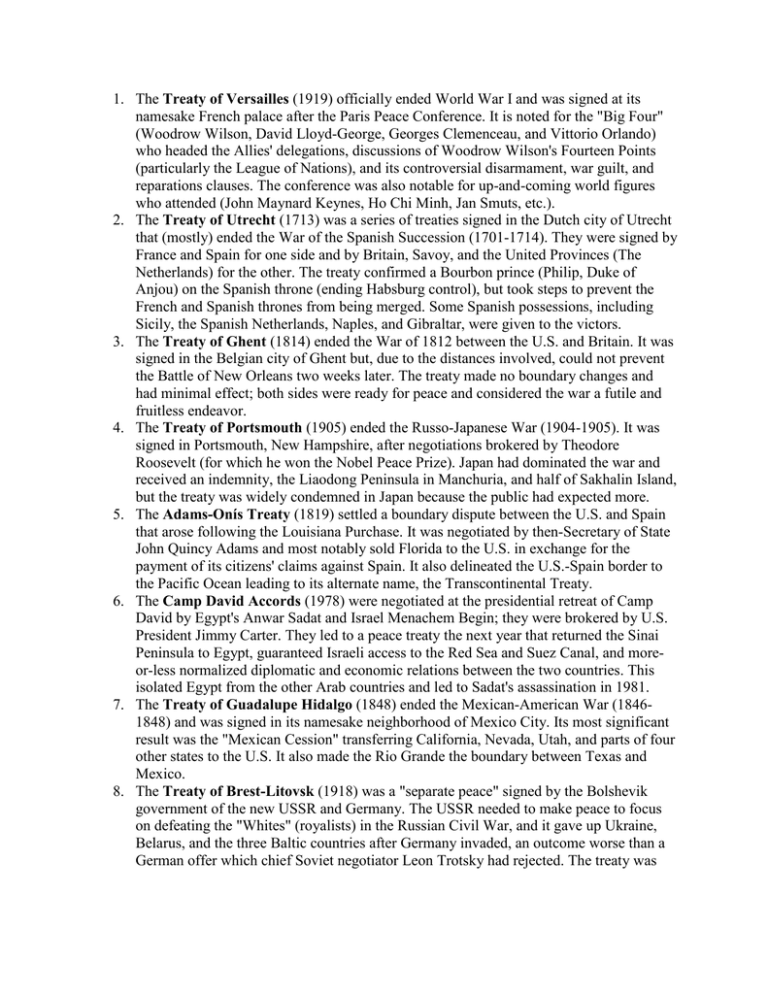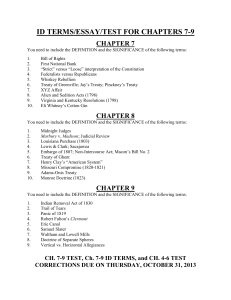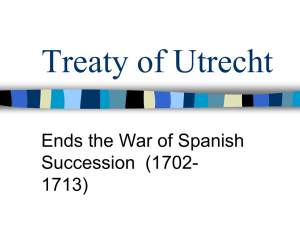Treaty of Versailles
advertisement

1. The Treaty of Versailles (1919) officially ended World War I and was signed at its namesake French palace after the Paris Peace Conference. It is noted for the "Big Four" (Woodrow Wilson, David Lloyd-George, Georges Clemenceau, and Vittorio Orlando) who headed the Allies' delegations, discussions of Woodrow Wilson's Fourteen Points (particularly the League of Nations), and its controversial disarmament, war guilt, and reparations clauses. The conference was also notable for up-and-coming world figures who attended (John Maynard Keynes, Ho Chi Minh, Jan Smuts, etc.). 2. The Treaty of Utrecht (1713) was a series of treaties signed in the Dutch city of Utrecht that (mostly) ended the War of the Spanish Succession (1701-1714). They were signed by France and Spain for one side and by Britain, Savoy, and the United Provinces (The Netherlands) for the other. The treaty confirmed a Bourbon prince (Philip, Duke of Anjou) on the Spanish throne (ending Habsburg control), but took steps to prevent the French and Spanish thrones from being merged. Some Spanish possessions, including Sicily, the Spanish Netherlands, Naples, and Gibraltar, were given to the victors. 3. The Treaty of Ghent (1814) ended the War of 1812 between the U.S. and Britain. It was signed in the Belgian city of Ghent but, due to the distances involved, could not prevent the Battle of New Orleans two weeks later. The treaty made no boundary changes and had minimal effect; both sides were ready for peace and considered the war a futile and fruitless endeavor. 4. The Treaty of Portsmouth (1905) ended the Russo-Japanese War (1904-1905). It was signed in Portsmouth, New Hampshire, after negotiations brokered by Theodore Roosevelt (for which he won the Nobel Peace Prize). Japan had dominated the war and received an indemnity, the Liaodong Peninsula in Manchuria, and half of Sakhalin Island, but the treaty was widely condemned in Japan because the public had expected more. 5. The Adams-Onís Treaty (1819) settled a boundary dispute between the U.S. and Spain that arose following the Louisiana Purchase. It was negotiated by then-Secretary of State John Quincy Adams and most notably sold Florida to the U.S. in exchange for the payment of its citizens' claims against Spain. It also delineated the U.S.-Spain border to the Pacific Ocean leading to its alternate name, the Transcontinental Treaty. 6. The Camp David Accords (1978) were negotiated at the presidential retreat of Camp David by Egypt's Anwar Sadat and Israel Menachem Begin; they were brokered by U.S. President Jimmy Carter. They led to a peace treaty the next year that returned the Sinai Peninsula to Egypt, guaranteed Israeli access to the Red Sea and Suez Canal, and moreor-less normalized diplomatic and economic relations between the two countries. This isolated Egypt from the other Arab countries and led to Sadat's assassination in 1981. 7. The Treaty of Guadalupe Hidalgo (1848) ended the Mexican-American War (18461848) and was signed in its namesake neighborhood of Mexico City. Its most significant result was the "Mexican Cession" transferring California, Nevada, Utah, and parts of four other states to the U.S. It also made the Rio Grande the boundary between Texas and Mexico. 8. The Treaty of Brest-Litovsk (1918) was a "separate peace" signed by the Bolshevik government of the new USSR and Germany. The USSR needed to make peace to focus on defeating the "Whites" (royalists) in the Russian Civil War, and it gave up Ukraine, Belarus, and the three Baltic countries after Germany invaded, an outcome worse than a German offer which chief Soviet negotiator Leon Trotsky had rejected. The treaty was negotiated in modern-day Brest (in Belarus) and was nullified by the subsequent Treaty of Versailles following Germany's defeat. 9. The Treaty of Tordesillas (1494) ostensibly divided the New World (and, in later interpretations, the entire world) between Spain and Portugal. It resulted from a bull by (Spanish-born) Pope Alexander VI granting lands to Spain and established a line west of the Cape Verde islands between future Spanish possessions (west) and Portuguese possessions (east). The line passed through Brazil, allowing the Portuguese to establish a colony there while Spain received the rest of the Americas. Endless wrangling and repeated revisions ensued. 10. The Peace of Westphalia (1648) is the collective name for two treaties ending the Thirty Years' War that were signed by the Holy Roman Empire, minor German states, Spain, France, Sweden, and the Dutch Republic. It confirmed the principle of "cuius regio eius religio" (that a ruler's religion determined that of his country) introduced by the Peace of Augsburg, but mandated relative tolerance of other (Christian) faiths. It adjusted the borders of German states and strengthened their princes with respect to the Emperor and transferred most of Lorraine and some of Alsace to France. 11. The Lateran Treaty (1929) created the independent country of the Vatican City, made Catholicism the state religion of Italy (ended in 1984), and determined the proper remuneration for Church property taken by Italy. It was signed by Benito Mussolini and a representative of Pope Pius XI in the namesake papal residence and ended the so-called "Roman Question" that arose out of the unification of Italy and the dissolution of the Papal States. 12. The Treaty of Paris (1898) was, surprisingly, the only Treaty of Paris to make the list. It ended the Spanish-American War and transferred Guam, the Philippines, and Puerto Rico to the U.S. while making Cuba (ostensibly) independent. The treaty was the beginning of American imperialism and underwent a lengthy and contentious ratification.





